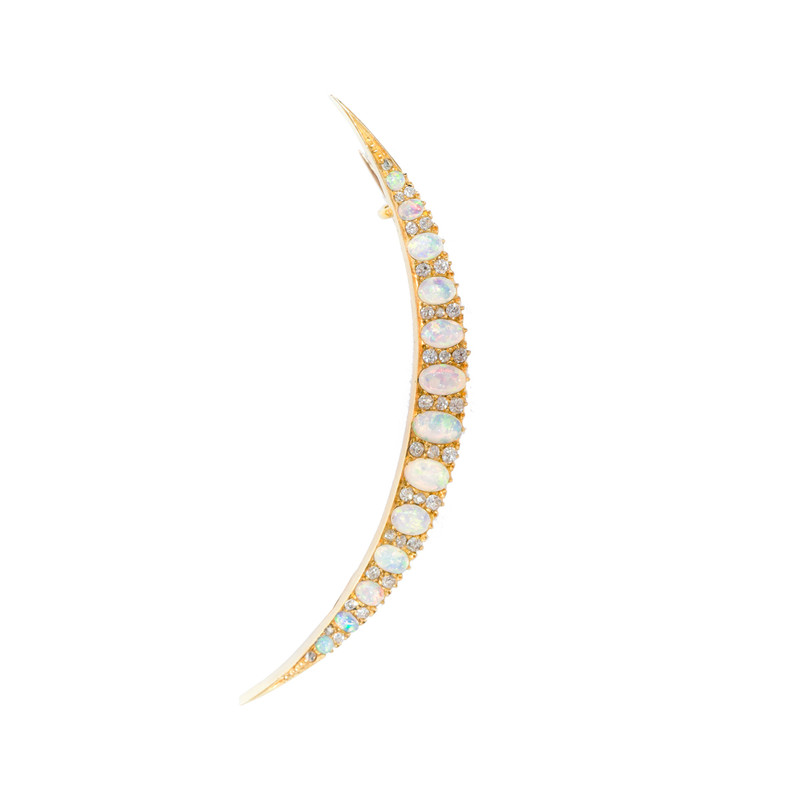Not always a lover of opals? The candy-colored play-of-color, ranging in shades of sky blue, lavender, pink and apple green, may change your mind.
The 18 Ct gold crescent shaped brooch is further enhanced by rows of diamonds set in between the opal cabochons. They sparkle with movement, a bit like stars beginning their twinkle against a blue-pink sunset sky.
19th and early 20th century celestial events like Halley’s comet and the Great September Comet captured the imagination of decorative artists. As a result, the popularity of related motifs (moons in all phases, stars, and of course comets) increased significantly.
Currently a brooch, it can be easily converted to a pendant. Ask us for cost/details!
Dimensions & Details
- The brooch is 18 Ct gold (tested) set with graduated opal cabochons and 32 old mine cut diamonds.
- The brooch is just under 2 1/2 inches in length and just under 1/4 of an inch at its widest point.
Origin
- England.
Period & Hallmarks
- Edwardian.
- Unmarked,18 Ct gold (tested).
Condition
- The brooch is in good antique condition with general wear and surface scratches that one would expect to see in a piece of this age.
- The clasp is in good working order.
More about Opals
Unlike many other precious gems (diamonds, rubies, sapphires, etc.) opals are not crystalline in structure, but are comprised of hydrated silica. While opals are found on other locations, the majority of the world’s opal supply comes from Australia. The industry tends to group precious Opals into the following categories.
Black Opals: The background ranges from dark greys to blacks and the foreground displays a play-of-color. Most opals are cut into cabochons. Black opals may be cut into unusual shapes to best capture the display of color.
White Opals: White opals have a lighter background which can range from white to light grey, the foreground displays a play-of-color.
Crystal/Water Opals: The term crystal opal can apply to a black opal, a semi-black opal or a white opal. It has more to do with its degree of transparency and in turn its play-of-color.
Boulder Opals: Boulder opals are found in ironstone boulders. They differ from other opals in that they are attached to the ironstone boulders and are difficult to separate successfully. They are usually cut with the natural boulder backing left in place. Ironstone can sometimes be seen on the surface (coming through in spots or veins). A boulder opal without any visible ironstone on its surface is more valuable.
Fire Opals: Fire opals have background colors that range from vivid yellows, to oranges and reds. They can be can be cut with facets or as cabochons like other precious opals. They may or may not have a play-of-color.
Opal Doublets: Usually a thin layer of precious opal on the surface, which is then adhered to another layer of material (e.g. rock, glass) to enhance its appearance and depth.
If you are interested in reading more about the jewelry terms or decorative periods referenced throughout our site, visit our Resources section for additional information.
Find out how to care for your collection of antique and modern jewels: visit our Jewelry Care page to get advice on maintaining and storing your treasured pieces.
Please note that in order to clean jewelry containing opals, you can use a wet cloth, but ensure that it is soft and not chemically treated. Do not dip them in cleaning solution or place them in an ultrasound cleaner. For more comprehensive information contact us or a knowledgeable jeweler.
Outside of the U.S.? Please contact us for a shipping quote.
Warranty Information
Additional Details
- SKU:
- #BG432










